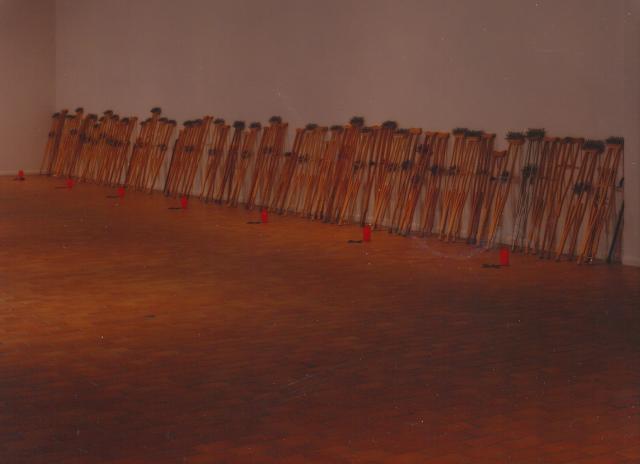
Exhibition
9 Jan 1995 - 26 Jan 1995
OPENING RECEPTION
Thursday January 12, 1995
8 – 10 PM
Similia Similibus Curentur
Blair Brennan
Similia Similibus Curentur culminates and transcends Blair Brennan's seven-year association in performances and installations with Brian Webb. This piece continues and sharpens Brennan's prior explorations of religious beliefs and practices as found in Magic/Magick/Miracles and (I Wanted to Know) The Exact Dimensions of Heaven. Similia Similibus Curentur may be seen as part of Brennan's attempt to overcome the ''secularization of our lives," the "separation [of art] from the rest of lived experience". Locked in the darkened gallery for days, placing with obsessively repetitive movements plum pits into pill bottles, 'improving' crutches with nails, and arranging crosses, rocks, hospital-worn stretchers, crutches and walking sticks, Brennan expects that the objects and the gallery space would be capable of functioning analogously to religious objects, namely as potential purveyors of some explanation or cure. He proposes to transform the Illingworth Kerr Gallery into ''sacred space," and the objects in it into ''sacred objects - consecrated through ritual use". Brennan makes clear that Similia Similibus Curentur is not just another performance/installation artwork.
The various artifacts in Similia Similibus Curentur may be seen as emblematic for faith of various kinds. The walking sticks and crutches in Ex-Voto, and the discarded hospital stretchers in To Heal and Protect Twelve People, are reminders of the devotees' faith in some curative practice. The plum pits and pill bottles in Seeds and Stones recall both our faith in the regeneration of nature and in pharmaceutical devices intended to slow down the recycling (disease and death) of human beings. The altar-like construction of As Above, So Below, with its Masonic G and surrounding rocks (some banded with steel bars and some not, recalling the two types of Masonic 'ashlars'), and the magical palindrome burned onto the stretchers, are representative for contemporary faith in magical practice. Finally the cross-like rakes and the clothes-line pole of In the Garden, and the candles, the small steel crosses, and the smell of incense filling the Gallery space, are reminders of the Christian faith.
Similia Similibus Curentur means "like cures like". This expression summarizes the central principle of homeopathy, an alternative medical practice according to which symptoms of illnesses may be relieved by small doses of the very same illness-causing substances. Given that the subject matter of the artifacts in Similia Similibus Curentur is faith of some kind, the ailment to be cured is faith.
It remains unclear, though, whether we are to be cured of our lack, or of our excess, of faith since it is uncertain whether the representation of faith in Brennan's piece is meant to be serious or ironic. In other words, given the homeopathic principle, we are being administered a dose of what ails us; but is it to rid us of our credulity or of our skepticism? Or is the dose already "individualized to the total physical and psychological traits of the client," as required by the prescriptions of homeopathy, such that it may make a sceptic out of the credulous, and a believer out of the unbeliever?
There is at least one other way in which this piece may be intended to cure like with like. Boldly declaring that the gallery has been turned into a sacred space through his ritual actions, Brennan challenges us to consider the process by which anything becomes sacral. One view may be that the sacred depends on a particular practice (requiring, for example, certain rituals). Hence, Brennan's piece may be intended to cure like with like through irony: if we despair of perceiving the sacred in this piece despite his earnest efforts at ritual sanctification, we may indeed become 'cured' of the belief that anything could attain sacral status through ritual action. It is, however, also possible to view Brennan's expressions of interest in magical homeopathy as so much indirection. Perhaps Brennan's point is that the sacred, as the mystics have long noted, is present in the everyday, whether recognized or not.
The sacred usually is contrasted with the secular. Emile Durkheim speaks of sacred things as "set apart and forbidden". Our societies' subordination of everything to instrumental, technological rationality has made it appear that nothing is sacred, that is, worthy of being set apart and forbidden. Insofar as traditional belief systems are replaced by scientific, reductionist belief systems, the everyday undergoes a progressive secularization. The focus on the sacred in Brennan's piece contributes to a re-assessment of the true status of things.
Brennan's ritual action constitutes a frame that extricates whatever is placed in it from being treated as of merely instrumental value. By taking prairie boulders, old hospital stretchers or clothesline poles out of their ordinary contexts they become foci for reflection on their non- instrumental value. By including stones (some girded with steel bands, and some not) in the gallery his piece helps to confirm ''that here and there -in the midst of the ever-accelerating transformation to which the earth is today submitted -stone still shines forth with a brilliance of sense that escapes those forces that would enclose and diminish it. " If the general trend of our times is toward increasing the secular instrumentalization of all things, Brennan's piece points to the resilient, unerased potential for re-cognition of the sacred in the world.
Exhibition Essay written by Thomas Heyd


